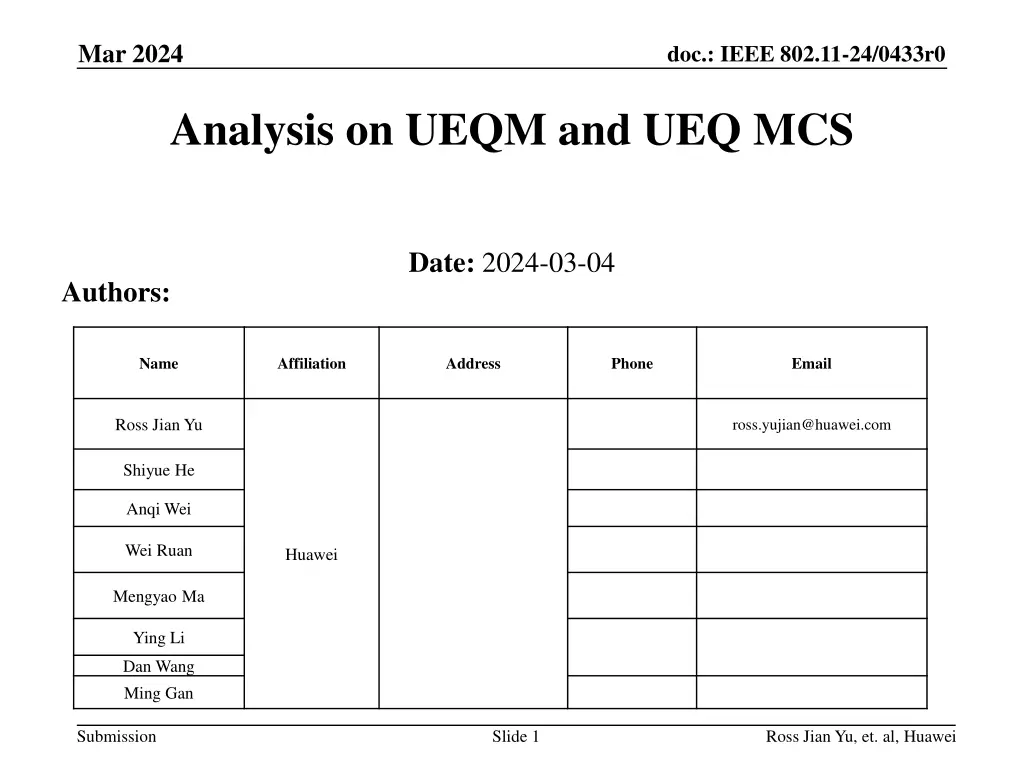
Analysis on UEQM and UEQ MCS for Cloud VR Applications
Explore the benefits of using unequal error protection (UEQM) and unequal MCS (UEQ MCS) for cloud VR applications. Learn how these techniques can enhance quality of service and reduce latency in high-demand scenarios. Discover the advantages of channel-selective gains and interference reliability provided by UEQ MCS. Consider the complexity and potential gains of implementing UEQ MCS for improved performance.
Download Presentation

Please find below an Image/Link to download the presentation.
The content on the website is provided AS IS for your information and personal use only. It may not be sold, licensed, or shared on other websites without obtaining consent from the author. If you encounter any issues during the download, it is possible that the publisher has removed the file from their server.
You are allowed to download the files provided on this website for personal or commercial use, subject to the condition that they are used lawfully. All files are the property of their respective owners.
The content on the website is provided AS IS for your information and personal use only. It may not be sold, licensed, or shared on other websites without obtaining consent from the author.
E N D
Presentation Transcript
Mar 2024 doc.: IEEE 802.11-24/0433r0 Analysis on UEQM and UEQ MCS Date: 2024-03-04 Authors: Name Affiliation Address Phone Email Ross Jian Yu ross.yujian@huawei.com Shiyue He Anqi Wei Wei Ruan Huawei Mengyao Ma Ying Li Dan Wang Ming Gan Submission Slide 1 Ross Jian Yu, et. al, Huawei
Mar 2024 doc.: IEEE 802.11-24/0433r0 Recap In [1-3], a detailed description on cloud VR use case has been presented, which needs high requirement on Tput and latency. Moreover, two aspects regarding latency reduction have been presented: QoS enhancement Unequal error protection (multi-layer/coding transmission/unequal MCS, separate encoders) Through simulations and analysis, we show that unequal MCS has the following benefits: Take advantage of the channel selective gains (spatial domain and frequency domain). Provide different protections for frames of different importance (spatial domain and frequency domain). Good for interference environment, errors happened in one RU layer doesn t affect the other RU (frequency domain UEQ MCS). In [4-7], simulation results show the benefits of unequal modulation (UEQM, single encoder) over EQM in spatial domain. Take advantage of the channel selective gains Submission Slide 2 Ross Jian Yu, et. al, Huawei
Mar 2024 doc.: IEEE 802.11-24/0433r0 UEQM vs UEQ MCS Channel Selective Gains We first show our results between UEQM and UEQ MCS. The simulation setup is the same as shown in [3]. We compare the following four cases: MC-MIMO (UEQ MCS) UEQM SU-MIMO 4SS (with equal power) SU-MIMO 3SS (with equal power) SU MIMO 4SS with unequal power SU MIMO 3SS with unequal power Other parameters are the same as before: 4 Tx and 4 Rx, 20MHz channel The simulations are based on real measured channels. Submission Slide 3 Ross Jian Yu, et. al, Huawei
Mar 2024 doc.: IEEE 802.11-24/0433r0 UEQM vs UEQ MCS Channel Selective Gains The results are shown below: CN=40 CN=18 MC-MIMO (UEQ MCS) shows gain over UEQM through the SNR range of interest for the LOS case and most of the SNR range for the NLOS case. Submission Slide 4 Ross Jian Yu, et. al, Huawei
Mar 2024 doc.: IEEE 802.11-24/0433r0 UEQM vs UEQ MCS Interference Reliability, especially reliability when interference exists is an important factor to consider in 11bn. Besides the channel selective gains, for UEQ MCS in frequency domain, as the encoders are independent in different RUs, the narrow band interference in one RU doesn t affect the data in another RU. The gains are shown in [3] and also pasted in the appendix of this slides for convenience. Submission Slide 5 Ross Jian Yu, et. al, Huawei
Mar 2024 doc.: IEEE 802.11-24/0433r0 UEQM vs UEQ MCS Complexity For UEQM, a single encoder and decoder is applied. For UEQ MCS, multiple encoders and decoders are applied. From the AP side, UEQ MCS in frequency domain is like OFDMA, and UEQ MCS in spatial domain is like MU-MIMO. From the non-AP STA side, UEQ MCS requires new capabilities like the AP to handle multiple PSDUs are needed. Worth to have considering the further gains of UEQ MCS If some vendor does have concern, can make this feature at the non-AP STA side optional. Submission Slide 6 Ross Jian Yu, et. al, Huawei
Mar 2024 doc.: IEEE 802.11-24/0433r0 Summary In this presentations, we show more results and analysis of UEQ MCS, and show its further advantage over UEQM and EQM. Submission Slide 7 Ross Jian Yu, et. al, Huawei
Mar 2024 doc.: IEEE 802.11-24/0433r0 Straw Poll 1 Do you agree to include the following into the 11bn SFD? 11bn defines unequal MCS in spatial domain. Different modulation orders and rate combinations in different spatial streams Y N A Submission Slide 8 Ross Jian Yu, et. al, Huawei
Mar 2024 doc.: IEEE 802.11-24/0433r0 Straw Poll 2 Do you agree to include the following into the 11bn SFD? 11bn defines unequal MCS in frequency domain. Separate modulation orders and rate combinations in different resource units Y N A Submission Slide 9 Ross Jian Yu, et. al, Huawei
Mar 2024 doc.: IEEE 802.11-24/0433r0 Reference [1] 11-22-0952-00-0wng-cloud-vr-use-case-and-requirements [2] 11-22-1930-00-0uhr-layered-qos-and-multi-layer-transmission [3] 11-23-0060-02-0uhr-layered-qos-and-multi-layer-transmission-follow- up [4] 11-24-0016-01-00bn-uhr-mimo-rvr-enhancement-with-unequal- modulation [5] 11-24-0113-01-00bn-unequal-modulation-in-mimo-txbf-in-11bn [6] 11-24-0117-01-00bn-improved-tx-beamforming-with-ueqm [7] 11-24-0176-01-00bn-unequal-modulation-over-spatial-streams Submission Slide 10 Ross Jian Yu, et. al, Huawei
Mar 2024 doc.: IEEE 802.11-24/0433r0 Appendix Submission Slide 11 Ross Jian Yu, et. al, Huawei
Mar 2024 doc.: IEEE 802.11-24/0433r0 Simulation setup MC-MIMO vs SU- MIMO 4T4R In previous simulations, we show the comparison of 4Tx, 4Rx, 4SS transmission between MC (Multiple Coding)-MIMO vs SU-MIMO where MC code can apply different MCS on different streams. Different PSDU are transmitted in different streams. The MC-MIMO shows at least 10%~15% gain over SU-MIMO. We receive the following comments regarding the simulations: For baseline SU-MIMO, 3SS sometimes can achieve higher Tput than 4SS for a 4Tx, 4Rx transmission. With unequal power allocation (waterfilling), the baseline SU MIMO can achieve better performance. Hence in this simulation, we compare the following four cases: MC-MIMO SU-MIMO 4SS (with equal power) SU-MIMO 3SS (with equal power) SU MIMO 4SS with unequal power* SU MIMO 3SS with unequal power* Other parameters are the same as before: 4 Tx and 4 Rx, 20MHz channel The simulations are based on real measured channels. *With unequal power allocation, the transmit power imbalance of each antenna increases. The power of some RF chan nels may exceeds a preset value, and the power of some channels is not fully used. Submission Slide 12 Ross Jian Yu, et. al, Huawei
Mar 2024 Simulation results MC-MIMO vs SU- MIMO 4T4R doc.: IEEE 802.11-24/0433r0 X-axis: channel SNR, Y-axis: Tput MC-MIMO still shows obvious gain over baseline SU-MIMO through the SNR range of interest for the LOS case and most of the SNR range for the NLOS case. Submission Slide 13 Ross Jian Yu, et. al, Huawei
Mar 2024 doc.: IEEE 802.11-24/0433r0 Simulation setup MC-MIMO vs SU- MIMO 2T2R We received further comments to show the performance for 2SS case. We further compare the following three cases: MC-MIMO 2SS SU-MIMO 2SS (with equal power) SU-MIMO 1SS (with equal power) Other parameters are the same as before: 2 Tx and 2 Rx, 20MHz channel The simulations are based on a real channel. Three directions with different condition number (CN) number are chosen: Submission Slide 14 Ross Jian Yu, et. al, Huawei
Mar 2024 Simulation results MC-MIMO vs SU- MIMO 2T2R doc.: IEEE 802.11-24/0433r0 CN: 4.8 CN: 20 CN: 30 X-axis: channel SNR, Y-axis: Tput MC-MIMO still shows obvious gain over baseline SU-MIMO. Submission Slide 15 Ross Jian Yu, et. al, Huawei
Mar 2024 doc.: IEEE 802.11-24/0433r0 Simulation setup MC-MIMO vs SU- MIMO 4T2R We received further comments to show the performance for 2SS case. We further compare the following three cases: MC-MIMO 2SS SU-MIMO 2SS (with equal power) SU-MIMO 1SS (with equal power) Other parameters are the same as before: 4 Tx and 2 Rx, 20MHz channel The simulations are based on a real channel. Three directions with different CN number are chosen: 5, 10, 15. Submission Slide 16 Ross Jian Yu, et. al, Huawei
Mar 2024 Simulation results MC-MIMO vs SU- MIMO 4T2R doc.: IEEE 802.11-24/0433r0 CN=5 CN=10 CN=15 X-axis: channel SNR, Y-axis: Tput MC-MIMO shows gain over baseline SU-MIMO when CN is 10 or 15, whilst usually CN<10. In general, no obvious gain. Submission Slide 17 Ross Jian Yu, et. al, Huawei
Mar 2024 doc.: IEEE 802.11-24/0433r0 Simulation setup Independent coding MRU vs joint coding RU/MRU Simulation results for interference environment are also provided. The total bandwidth is 80 MHz, AWGN channel. The Power RSSI is -50dBm. The interference is added to the upper 40 MHz (defined as RU 1). The interference occupies 50% and 90% of the total time respectively. Three cases are compared: SU case: joint coding over the whole bandwidth, following the current procedure SU Punc case: joint coding over the non-interfered potion of the total bandwidth (lower 40 MHz, defined as RU 0). More accurately, this is a smaller bandwidth transmission. MRU case: independent coding MRU case, the data is encoded separately in RU 0 and RU1. 1T1R. Throughput is optimized regarding all supported MCSs. Upper 40 MHz, RU 1 Interference Lower 40 MHz, RU 0 Submission Slide 18 Ross Jian Yu, et. al, Huawei
Mar 2024 doc.: IEEE 802.11-24/0433r0 Simulation results Independent coding MRU vs joint coding RU/MRU Independent coding MRU case shows obvious throughput gain compared with SU case and SU punc case. Submission Slide 19 Ross Jian Yu, et. al, Huawei
Mar 2024 doc.: IEEE 802.11-24/0433r0 Simulation results Independent coding MRU vs joint coding RU/MRU Independent coding MRU case shows obvious throughput gain compared with SU case and SU punc case. Submission Slide 20 Ross Jian Yu, et. al, Huawei









